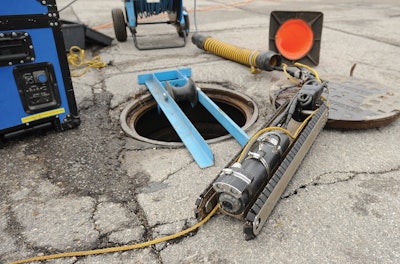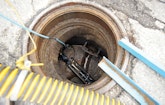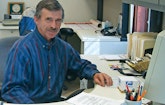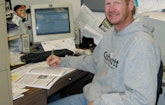Interested in Cleaning?
Get Cleaning articles, news and videos right in your inbox! Sign up now.
Cleaning + Get AlertsAt about $300,000, the Wisconsin village of Belgium’s entire public works budget is less than the salary of the President of the United States.
“Usually we don’t have much of a budget for buying new equipment,” says Daniel Birenbaum, director of public works. Capital expenditures for the entire village were zero in 2009 and 2010. For such a tiny community, even a modestly priced sewer camera would seem beyond reach, especially since it wouldn’t get used every day.
Yet since the late 1990s, Birenbaum has had access to a pair of camera units from UEMSI just about whenever he has needed them. His community, along with the villages of Adell, Cedar Grove, Fredonia and Oostburg in Sheboygan and Ozaukee counties, has pitched in to purchase the cameras, pay for their maintenance, and share their use.
It has been an ideal way for the five to get access to advanced sewer inspection technology at an affordable cost, and now they’re looking at a possible upgrade.
Previous experience
The five villages, populations from about 500 to 2,000, are all six to 12 miles apart in an area just west of Lake Michigan and about an hour’s drive north of Milwaukee. This isn’t the first time they have shared equipment. In the late 1980s, Birenbaum recalls, Belgium got a call from Cedar Grove suggesting the joint purchase of a valve-exercising unit. Adell and Oostburg kicked in as well.
And the communities have a long history of working together just to swap tips and share problems, especially in public works matters. “We talk among each other because we’re all small communities,” says Birenbaum. “We deal with the same problems.”
Birenbaum recalls that getting a sewer camera was his idea, as the villages grappled with the need to do a more cost-effective job of locating blockages and leaks in sewers. Contractors weren’t an ideal alternative. “There are only three contractors around that do camera work, so the price is up there,” says Jeff Kreutzinger, public works director for the Village of Adell. “Plus, the last time I checked, they’re backed up six to eight months before you can get them out.”
For emergencies, contractors are not really an option. And with prices starting at about $10,000, for just one village to buy a camera was out of the question. “For one community that’s a lot of money,” says Birenbaum. “We just got together and thought, if everybody would go together on the purchase that way and bring the cost down, then we’d have a camera.”
Step-by-step upgrades
At first, Adell wasn’t part of the deal. Belgium bought the first camera in the mid-1990s and was reimbursed by the other communities for their shares. “We started out with a black-and-white one on a push reel with a 100-foot cable,” says Birenbaum. That unit, a Chaser from UEMSI, cost about $3,600.
In 1998, the communities up-graded, trading in the unit for a reconditioned color Predator 2 camera unit from UEMSI for about $8,500. That included a new push-reel cable.
In 2000, the communities up-graded again, getting a Predator Advantage with an FNR-Trax tractor for $13,400 and a 500-foot cable and a power rewind unit. That’s also when Adell bought in to the program.
A year or two later they spent a few hundred dollars more for a second camera head, allowing them to have separate camera heads for the tractor and the old push reel. “Then we didn’t need to keep switching camera heads,” Birenbaum says.
The current unit is pretty basic — it doesn’t have pan-tilt-zoom capability, for example. But the villages did get a light-head kit for larger pipes, and the tractor unit can be used in pipes from 6 to 12 inches.
The purchases didn’t include a dedicated truck. Instead, the cameras are interchanged with a portable control and monitor unit with a VCR to tape inspections.
Paperwork-free
Birenbaum recalls that the participating communities signed a simple written agreement when the program was put in place. Beyond that, the arrangement runs with informality that befits small-town America. The cameras are stored in Cedar Grove, chosen as the central location.
There’s no formal checkout system or documentation. If one community needs a camera, “Typically they’ll give a call to make sure it’s here,” says Cedar Grove public works director Paul Dekker. “They’ll come and pick it up, and as soon as they’re done with it, bring it back. If someone else has it, they call that community. It’s all verbal.”
Usage can vary. “Sometimes it’s out two or three times a week,” says Dekker. “Other times it will be here for a month at a time.”
Everyone understands about priorities, as Al Neumann, public works director for Fredonia, can attest. A couple of years ago, “Oostburg had the camera lined up to do some storm sewer work, and we had a sewer backup that became an immediate need,” says Neumann.
Fredonia called Cedar Grove and learned that the camera was in Oostburg. So Neumann called his Oostburg counterpart, who had the camera transported to Fredonia. “We all know each other, and we’ve had excellent working relationships,” says Neumann.
When it comes time for repairs, Belgium’s Birenbaum takes the lead in lining that up, and the bill is split five ways.
Convenience and savings
The five communities all report typical jobs for the camera, and nothing especially exotic. They use it to inspect laterals and diagnose blockages. They hunt for leaks, especially those that contribute to inflow and infiltration to the sanitary sewers.
“We have found cracks and offset joints and root intrusion,” says Neumann. “Once we actually used it in a new house that had blockages and we found some old rubber gaskets wedged crosswise in the pipe there. We’ve seen a lot of things.”
Kreutzinger, of Adell, says the push camera can be useful to point out problems to homeowners with clogged or broken laterals. And universally, the officials point out the obvious but important benefit of televising sewers, especially to identify a problem: “It allows workers to pinpoint a problem and decide exactly where to dig, so we can avoid unnecessary excavation.”
A downtown Adell rehabilitation project benefited greatly from using the camera to inspect the sewer lines first. “We took measurements off where the laterals were,” Kreutzinger says. “You knew exactly where the laterals were that went into people’s houses, so when you were excavating for the street project, you didn’t hit them.”
Adds Birenbaum: “It’s one tool you can use to find your problems without digging the whole street up.”
Looking to upgrade
Birenbaum says the five communities are talking about upgrading the camera, especially because they would like to switch to DVR recording, which he recently saw demonstrated. “That was really a nice unit,” he says.
But without the option of sharing the camera, says Neumann, “We wouldn’t have been able to afford it. I don’t think it would have gotten approval by the village board.”
Sharing makes sense, Kreutzinger adds, because no single community could easily justify the cost on its own. “It’s something that you don’t use every day, but it’s really nice to have when you need to use it,” he says. “It makes no sense for all five of us to own a camera when it would get limited use. If we didn’t share it and split the cost, we wouldn’t have access to it.”
But they do share. And the result is better service at a cheaper price for all.











